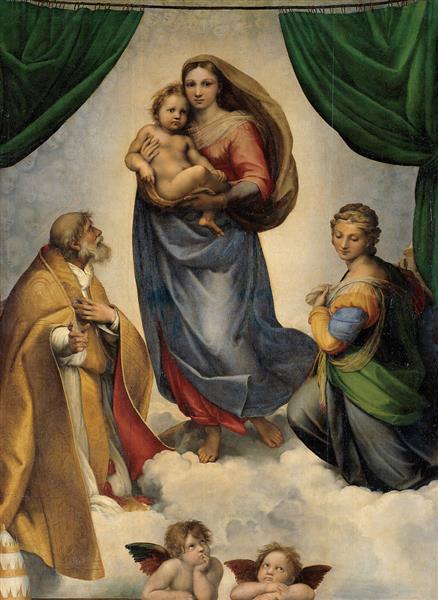Descriere
The Sistine Madonna, painted by Raphael in 1513, is one of the most recognized and admired masterpieces of the Renaissance. This oil on canvas painting, currently kept in the Old Masters Gallery in Dresden, Germany, stands out not only for its technical beauty, but also for the spiritual depth that emanates from its compositions and characters.
At the center of the work is the figure of the Virgin Mary, who is presented as a protective and sacred mother. The Virgin, wearing a red cloak and white veil, radiates an aura of majesty and tranquility. Her face is full of serenity and kindness, emphasizing her role as the Mother of God. In her arms she holds the baby Jesus, who, with his inquisitive yet divine expression, seems ready to interact with the viewer. The relationship between mother and child is palpable and transcendent, symbolizing maternal love in a spiritual context.
The composition of the painting is remarkably balanced. Raphael uses an architectural background that, although vague and idealized, complements the figures in the foreground. The arrangement of the figures forms a pyramid, which is a classic form in Renaissance painting that lends stability and harmony to the work. This use of the pyramid becomes a distinctive feature of Raphael, who seeks to guide the viewer's gaze towards the central point, where the connection between the Virgin and Child is found.
The angels flanking the Virgin and Child add an almost ethereal element to the work, contributing to the perception of the divine. These characters, with expressions of wonder and curiosity, are presented as witnesses to this sacred scene. Their cartoonish and lively faces contrast with the more solemn figures in the foreground, creating a visual dialogue that invites the viewer to reflect on the duality of the human and the divine.
The use of colour in The Sistine Madonna is a crucial aspect that deserves attention. The palette is based on saturated and vivid colours: the red of the Virgin's tunic, the blue of the cloak in the background and the golden tones in the halo surrounding the Child, which generate an extraordinary visual richness. Raphael was known for his mastery in the application of colour, which not only serves to embellish the work, but also symbolises different spiritual and emotional aspects. Red, for example, which is often associated with passion and motherhood, is used by the artist to emphasise the importance of the Virgin in sacred history.
The Sistine Madonna is not only a representation of the Virgin Mary and the Christ Child, but it reflects the time in which it was created, an era of renewed artistic thought and expression. Raphael, in his quest to combine classical serenity with the emotionality of the Renaissance, achieved a balance that few other artists achieved. The work has influenced later generations, offering a model of composition that will be replicated and reinterpreted throughout the history of art.
Intriguingly, The Sistine Madonna is also remembered for being Raphael’s last major work before his untimely death in 1520. This fact adds a layer of melancholy to the painting, as if encapsulating the culmination of his artistic and spiritual vision. The work, in its elegance and depth, remains an enduring testament to Raphael’s mastery and the profound emotional impact art can have on humanity. His legacy lives on in every detail of this painting, offering not only admiration for its beauty, but also a space for contemplation and connection with the divine.
KUADROS ©, a famous painting on your wall.
Hand-made oil painting reproductions, with the quality of professional artists and the distinctive seal of KUADROS ©.
Painting reproduction service with satisfaction guarantee. If you are not completely satisfied with the replica of your painting, we will refund 100% of your money.

